|
1.
CENTRAL/ WEST AFRICA
Summer holidays in Europe slow market
In the West African region, log trading was very slow and
there was no sign of a revival. Okoume prices for China
have fallen by EUR2-3 m³ but old stocks in Gabon were
being shipped to China at the low price of EUR75 m³
FAS. Hopefully, this will help stabilize the market,
although exporters report that trade even in the premium
species has been very low and difficult to negotiate.
European markets are almost closed during the summer
vacation period and exporters do not expect any change
until mid-September, when buyers normally begin to
assess requirements for the final quarter. Most log prices
remained unchanged over the past 3-4 weeks, largely
through lack of interest from buyers rather than a
reflection of stability, while producers continued to restrict
production and lay off workers. Log stocks were very high
in importing countries in Asia and Europe so there was no
incentive to even begin to assess future needs.
For sawn lumber, prices remained unchanged after recent
falls in moabi, sapele and sipo prices. With the European
market virtually closed during August, there has been very
little trade activity on which to base current prices.
Moabi and douka were reported as overstocked in Europe
and exporters were expecting further downwards pressure
on prices. Sapele prices were very weak and sellers were
willing to look at even very low offers to clear stocks.
Even so, there were very few enquiries for almost all sawn
lumber species and virtually no serious offers on the table.
In Gabon, the government was using the current downturn
in timber business to take a much tougher stance on
regulations and contractual obligations that companies had
taken as part of their forestry agreements. At least two
foreign owned companies were closed for failing to
comply, and others were under caution.
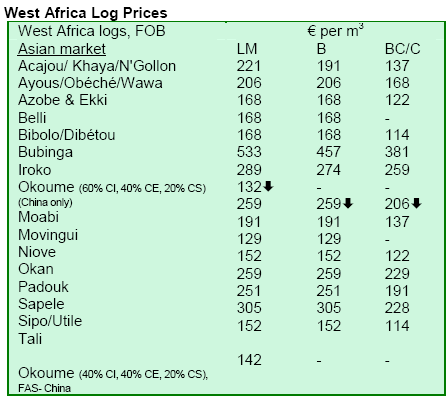
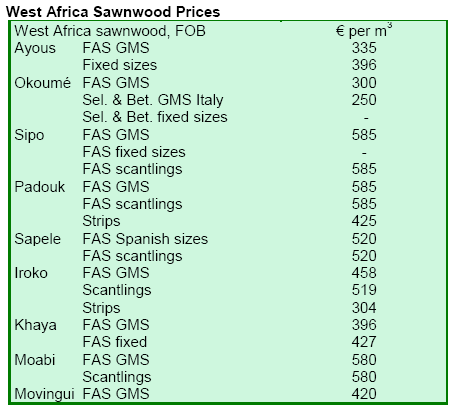
2. GHANA
Ghana receives new credits for natural resources
The World Bank has recently approved four credits
totaling USD157 million to support Ghana's budget under
the multi-donor budget support (MDBS) framework.
MDBS is a harmonized partnership framework in which
the government and a number of its development partners
provide direct funding for the implementation of the
Ghana Growth and Poverty Reduction Strategy through
the annual budget. Since its inception in 2003, a total of
USD1.7 billion has been disbursed under the framework,
with over USD700 million coming form the World Bank
alone, through six Poverty Reduction Support Credits. The
four agreements recently signed through the International
Development Association (IDA) of the World Bank were
allocated to: Natural Resources and Environmental
Governance (NREG) (USD20 million); the Agricultural
Development Policy Operation (USD35 million); West
African Transport and Transit Facilitation Project (USD80
million); and the Community-based Rural Development
Project (USD22 million).
Mr. Kwadwo Baah-Wiredu, Ghana¡¯s Minister of Finance
and Economic Planning, signed one of the USD20 million
Natural Resource and Environmental Governance (NREG)
credits in Accra. The NREG supports governance reforms
in the interrelated sectors of forestry and wildlife, mining
and environmental protection to ensure effective forest law
enforcement; improve revenue collection, management
and transparency; address social issues in forest and
mining communities; and mainstream environmental
protection into growth. At a press briefing in Accra, Mr.
Diwan said these operations were focusing on accelerating
the kind of growth that benefited the poor, improving
environmental sustainability for the benefit of future
generations, supporting the delivery of basic services,
especially water to the citizens across the country, and
continuing to work towards better and more inclusive
governance.
Timber companies owe FC GHc12.4 million
According to The Daily Graphic, Mr. Kwadwo Agyei
Addo, Member of Parliament, recently inquired to
members of the government about the amount of fines
owed by timber firms and the measures that had been put
in place to recover them. In response to the query, Ms.
Esther Obeng Dappah, Minister for Lands, Forestry and
Mines, reported that one hundred and twenty seven timber
firms in the country owe the Forestry Commission (FC)
Ghc12.4 million, which consist of stumpage fees and
outstanding liabilities on the payment of fees for timber
rights.
The Minister said there was an initial outstanding GHc1.7
million in 1999 for stumpage fees, and debt had
accumulated to date as a result of injunctions put in place
by the courts following the Ghana Timber Association¡¯s
(GTA) challenge of the stumpage fee payment calculations
made by the FC. On the issue of fees for timber rights, Ms.
Dappah indicated a debt of GHc7.6 million had
accumulated since 2003 due to non-payment of pledges
made by timber firms.
The Minister outlined measures being pursued by her
Ministry for the collection of the outstanding balances.
She indicated that since January 2008, the FC and the
Ministry had engaged consultants to begin a judicial
process to retrieve those debts as required by law. The first
legal report from the consultants is expected at the end of
August.
The settlement of outstanding debts by timber firms has
also been made a pre-condition to the semi-annual renewal
of property marks. With these measures in place, it was
expected that the debt would be significantly reduced this
month when companies renew their property marks. Those
who fail to do so by September 2008 would forfeit their
rights to harvest timber.
Ghana¡¯s inflation rate rises on increased cost of services
Ghana¡¯s inflation rate accelerated to 18.4% in June from
16.9% in May, reflecting the rising cost of services,
transport and food in West Africa. The Ghana Statistical
Service said there was a risk of a further increase in the
rates unless the global economic outlook improved. The
country¡¯s inflation rate has climbed steadily since October
2007, despite the Bank of Ghana¡¯s decision in April 2008
to raise the prime interest rate by a larger than expected
175 points to 16%.
The Ghana cedi has also depreciated by 12.81% against
the US dollar and 23.26% against the euro, when applying
Ghana Association of Bankers year end rates. Analysts
expect the cedi to depreciate further and do not expect any
change in this trend.
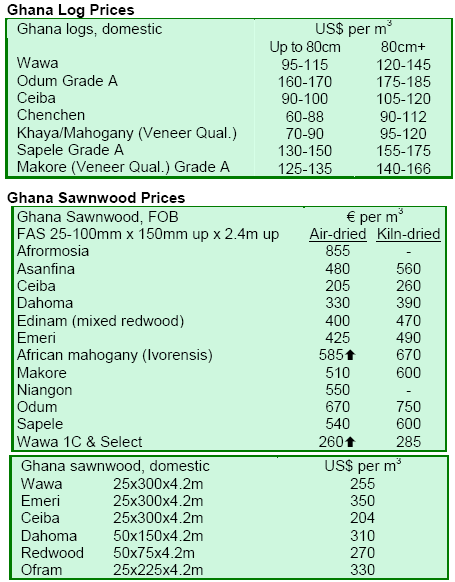
3.
MALAYSIA
MTIB to build furniture hub in Johor
Bernama reported on the Malaysian Timber Industry
Board¡¯s (MTIB) plans to build a ¡®furniture hub¡¯ in Johor
for the southern region of Peninsular Malaysia. MTIB has
selected a 1.96 hectare site in Mukim Tebrau, in the
southern state of Johor, to establish a furniture and
commercial timber products exhibit. The 300,000 square
foot center was expected to start operating under the 10th
Malaysia Plan.
The MTIB has reported that the cities of Muar and Johor
Baharu contributed nearly RM3 billion to the total value of
furniture exports from the country. Johor has been
identified as the city with the highest value of furniture
exports. Muar is also important, with about 80% of Muar¡¯s
population having some involvement in the furniture and
timber product industries.
Experts warn of effects of strong ties between Malaysian
and US economies
Experts have been considering the potential effects of the
US economic slowdown on Malaysia, reported The Star.
Some experts have speculated that Malaysia is less
isolated from the effects of the US economic downturn,
counter to previous arguments that there is a decoupling
between the US and Malaysian economies.
Experts recalled the US dotcom bust in the US, explaining
that Malaysia¡¯s economic growth rate slid to 0.5%
subsequent to the event. A series of collapsing US banks
and the US government bailout of Fannie Mae and Freddie
Mac have already impacted some European and Asian
economies. Moreover, analysts expect that the US¡¯s
economic problems will continue.
Experts note that this news does not bode well for the
Malaysian economy, saying that a hike in Malaysia¡¯s
interest rates might be necessary to curb inflation and
could adversely affect domestic investment. The US also
remains the single largest export destination for Malaysian
products and, if exports decline, this may also have an
impact on investment.
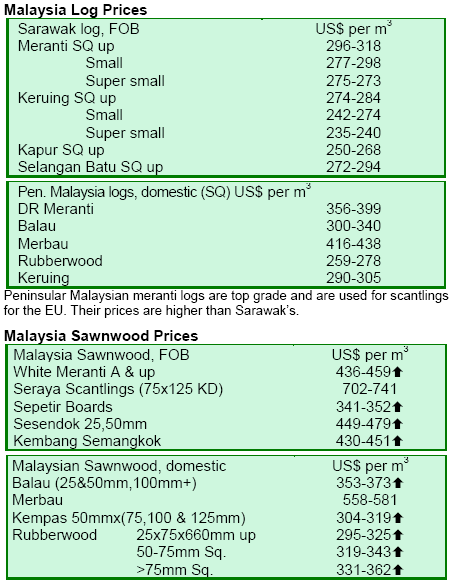
4.
INDONESIA
EU grants Indonesian imports duty-free facility
The EC recently stated in a press release that the EU will
provide a duty-free import facility for Indonesian wood
sheets, which was previously set at three to six percent.
Antara News also said the EC is expected to establish a
similar facility for Indonesian plywood, which will set a
duty of around 3.5%, instead of its previous range, 7-10%.
The lower import duty for plywood was set up under a
Generalized System of Preferences (GSP) facility program
by the EC, which is in effect from 1 January 2008 until
2011. In 2007, almost 40% of Indonesian exports to the
EU were eligible for benefits under the GSP facility, with
Indonesia gaining almost EUR3 million as a result of the
facility.
Disagreements hamper establishment of conservation
zones
According to The Jakarta Post, plans to establish the
Bukit Tigapuluh National Park (TNBT) have been slowed
due to disagreements between four districts within the
conservation zone. The four districts, two in Jambi and
two in Riau, have not yet agreed on the plans for the zone,
and the Minister of Forestry¡¯s regional conservation
director, Nur Hidayat, said many problems have yet to be
resolved. Institutions have proposed the current boundaries
of the park be expanded to include a 94,000 ha buffer
zone, although this area is located in a number of districts.
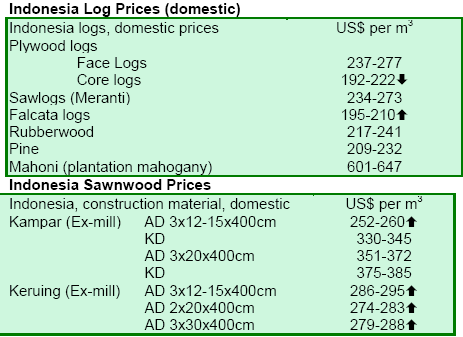
5.
MYANMAR
Market steadily slows for Myanmar teak
The market for Myanmar teak continued to slow through
end July. However, non-teak hardwood was reported to be
selling quite well in the markets.
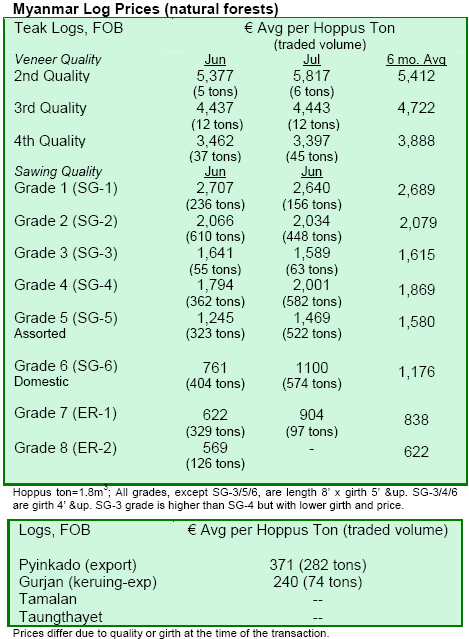
6.
BRAZIL
PNAS claims Brazil is responsible for 48% of tropical
deforestation
Reports from Portal Ecodebate and Celulose Online said
world deforestation rates by area reached 272,000 km²
between 2000 and 2005. According to the Proceedings of
the National Academy of Sciences (PNAS), Brazil was
responsible for 48% (26,000 km²) of the total tropical
deforestation in the period, followed by Indonesia, with
12.8% (7,000 km²). However, the Ministry of
Environment disagrees with Brazil¡¯s annual average
annual deforestation rate presented in the PNAS study (see
also TTM 13:10). The Ministry claims the correct number
is 21,450 km², a figure published by the National Institute
for Space Research (INPE). The Ministry suggests that the
research by PNAS does not take into account the period
from July 2004 to August 2007, when deforestation
decreased in Brazil.
The PNAS research stated that nearly 55% of
deforestation was concentrated in only 6% of tropical
rainforests, or highly threatened ¡®hotspots¡¯ that contain
large areas of biodiversity. The methods used to detect
deforestation in the study combined the use of the satellite
systems Modis and Landsat (which is more precise) to
help create global monitoring protocols. The research was
one of the first studies to estimate deforested areas in
tropical rainforests.
Government works to collect more environmental fines
The Brazilian government intends to change a law on
environmental crimes to guarantee increasing swiftness in
the payment of fines imposed on those that damage fauna
and flora, and pollute or degrade the environment, said
Ag¨ºncia Brasil and Remade. The Brazilian Institute for
Environment and Natural Renewable Resources (IBAMA)
has stated that BRL3.45 billion in fines were imposed
during 2006-2007. However, less than 10% of this amount
was effectively collected by the government, according to
estimates of the Ministry of Environment.
IBAMA does not have the exact percentage of fines
effectively collected, but confirmed the MMA estimates of
fines imposed. According to IBAMA, 34% of violations
concentrate in nine states of the Brazilian Amazon, but are
80% of the total value of fines applied during the period.
The state of Mato Grosso ranks the first in number of
violations, accounting for BRL 1.41 billion in the last two
years; a large part of which, BRL 1.3 billion related to
violations, such as deforestation, illegal trade and forest
products transportation. The state of Par¨¢ ranks second,
with BRL 724 million in fines, followed by Rondônia,
with BRL 280 million during the period.
A survey on the monitoring operations carried out by
IBAMA during the 2006-07 period revealed that the
Institute imposed up to BRL 20 million in a single fine. In
May 2008, however, a farmer was fined BRL 30.6 million
due to environmental degradation in his farm, located in
the buffer-zone of the Raposa Serra do Sol Indian Reserve.
According to the law, fines on environmental crimes can
vary from BRL50 up to BRL50 million each.
First semester furniture export results positive in some
Brazilian states
Following positive results in January 2008-May 2008 (see
TTM 13:13), Brazilian furniture exports in the first
semester of 2008 have increased slightly (0.3%) in the first
semester of 2008, when compared to the same period in
2007. Venezuela was the largest importer of Brazilian
furniture, showing a 53% increase when compared to the
first semester of 2007. Argentina increased its overall
imports by 50%, while the US reduced its Brazilian
furniture imports by 30%.
According to MDIC and CGI Moveleiro, Rio Grande do
Sul continued to be a major furniture producing State in
Brazil, with exports of USD138 million by value during
the first semester of 2008. Venezuela purchases of wood
furniture from that State increased 272%. The UK, which
imported 7% less when compared to the first half of 2007,
imported the same amount by value as Argentina,
amounting to 13% of total furniture exports of Rio Grande
do Sul. However, Argentina grew its purchases from Rio
Grande do Sul by 52%. US imports decreased 40% over
the period, accounting for 7% of the total export of the
product by the State.
Regarding Brazilian furniture exports by other states, São
Paulo was responsible for the highest increase in furniture
exports (22%), representing 15% of Brazil¡¯s total exports
of furniture in the first semester of 2008. The Southern
state of Paran¨¢ also showed a favorable trend, with an 11%
increase in exports, accounting for 12% of the country¡¯s
furniture exports of the country during the period. The rise
in exports was attributed to a combination of factors such
as sales to new markets, higher product quality, and higher
attendance of producers in key international events of the
sector, despite the continuous appreciation of the Brazilian
Real.
Nevertheless, not all states held positive results in the first
half of the year. Minas Gerais and Santa Catarina
decreased their sales to foreign markets by 12% and 11%,
respectively. Furniture manufactured in States with large
exports such as Santa Catarina¡¯s Rio Grande do Sul
mostly use wood from plantation forests and a mix of
solidwood and reconstituted-wood panels.
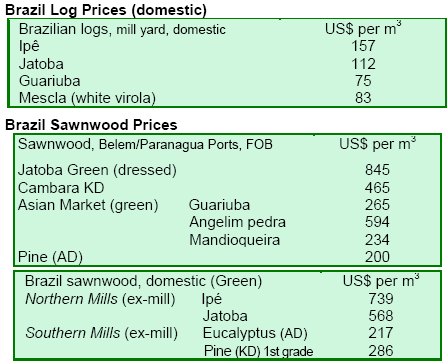
7.
PERU
Peru redirects furniture to new markets
Although Peru¡¯s exports of wooden furniture to the US fell
26.5% by value during the first quarter of 2008, the US
market remains the main destination of wooden furniture,
accounting for 60% of exports between January and May
2008. Exports of wooden furniture previously delivered to
US markets have been redirected to new markets such as
Italy, Venezuela and Chile.
US port in Tampa to receive Peruvian imports
The naval agency Maynas S.A. has announced that Tampa
Port in Florida will replace Port Everglades as the
receiving port for Peru¡¯s wood products. The destination
port of Peru¡¯s exports to the US recently changed as
Tampa became more equipped with the facilities and
specialized management of heavy loads, equipment and
machinery for imports and exports, while Port Everglades
has focused more on receiving passenger ships. Currently,
the M/N Yacu Puma is the only Peruvian ship that
transports wood products from Loreto to Mexico and the
US.
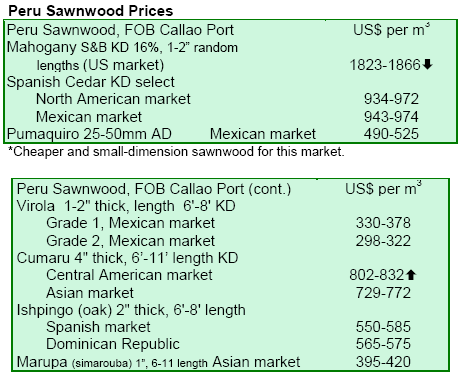
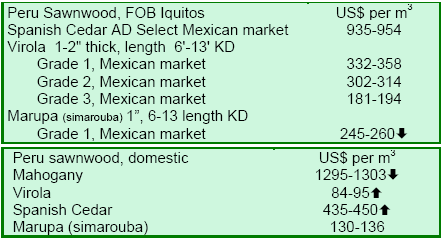
8. BOLIVIA
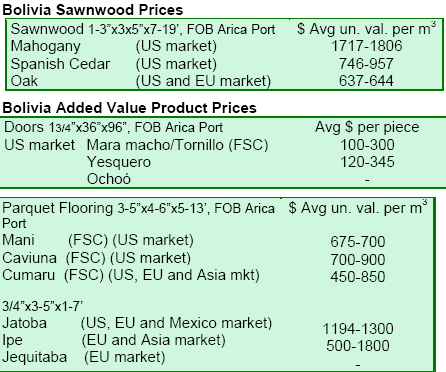
9. MEXICO
National Forestry Agency to expand commercial forest
plantations
According to the National Forestry Agency CONAFOR,
the agency plans to support projects for commercial forest
plantations in 2008. The projects, worth a total of 850
million pesos, will cover 80,000 ha of the country where
businesses will be established over the next few years
through Mexico¡¯s ProTree programme. The plantations
will be established primarily in the areas of Chiapas,
Veracruz, Tabasco, Campeche and Oaxaca. In 2008, fast
growing species such as teak, melina, mahogany, cedar
and pine are to be planted. In the last 10 years, the Federal
Government has financed about 7,000 projects covering
over 600,000 ha and costing approximately 4 billion
pesos.
Mexico to host Forest Expo in September
From 4-6 September 2008, Mexico will host Forest Expo
2008, which will be entitled ¡®Facing Climate Change and
Poverty in the Forest Sector¡¯. The Expo, which will be
convened in Guadalajara, in the state of Jalisco, will focus
on the exchange of experiences, opinions, challenges, and
proposals focused on sustainable development and the
preservation of the environment.
The exhibition will cover a total of 8,000 square meters
and over 400 national and international companies are
expected to attend. The international pavilions are
expected to host organizations such as ITTO, Cuenca
Forestal del Golfo, the Mexico-Canada alliance, the
International Agriculture Development Fund, the World
Bank, and the Rainforest Alliance, among others. More
information on the Expo is located at
www.expoforestal.com.
10.
GUYANA
Guyana posts strong results for July 2008
Log exports recorded for July 2008 are 11% greater by
volume than the combined total for May and June 2008.
Exports of Guyana¡¯s logs to China continue to increase
with the year-to-date total being higher than the 2007
figure by approximately 5% by volume. The slight rise
was caused by an increase in consumption of wamara logs
being consumed in China¡¯s market. In 2008, the export
volume of wamara logs was 48% greater than that of same
period of 2007, with July¡¯s volume exceeding a previous
record high by more than 42%. This trend also indicates an
increasing demand for wamara logs in the Chinese market
since August 2007.
Year-to-date comparison of sawnwood reveals that greater
volumes of sawn lumber are being exported at higher
prices and have increased 18% by volume and 26% by
value from the same period in 2007. The prime destination
for sawnwood for the month of July was The Netherlands,
with the dominant export being wamara.
Meanwhile, the fortnight¡¯s volume of roundwood exports
is up by more than four times the previous fortnight¡¯s
figures. This alone contributes to approximately 15% of all
roundwood exports for the year, owing to a higher demand
for greenheart piles from the US. Plywood exports by
volume, on the other hand, are showing some signs of
improvement from the combined results for May and June
levels, with the US being the primary destination for
exports.
Guyana¡¯s log export policy set for implementation in
2009
His Excellency Bharrat Jagdeo, President of Guyana, on
29th July announced the implementation of a National Log
Export Policy which will take effect from January 2009.
This policy will increase the export commission rate on
key species used in value-added production in the local
industry in Guyana. The export commission rate on logs is
currently 2%.
The President explained that the decision had been taken
following concerns by various stakeholders about the need
for the stimulation of more value-added activities in
Guyana, and for downstream processors of logs to receive
adequate supplies of materials. Other options, including a
ban on log exports were also considered in the process of
developing the policy.
The new policy is designed to reflect a differentiated
regime for the export commission by log species, and will
encourage the utilization of lesser known species of logs in
Guyana¡¯s classes 2 and 3. There are three parts of the
policy, which will take effect from January 2009:
The first part of the Policy will raise the export
commission rate to 7% with effect from January 2009,
10% from January 2010, and 12% from January 2011 up
to December 2011, for the following species: purpleheart,
red cedar, letterwood, bulletwood, cow wood, tatabu,
kabukalli, shibadan, tauroniro, washiba, hububalli, tonka
bean, darina, greenheart, and brown silverballi.
The second part of the policy will result in a higher export
commission rate of 7% in January 2009 and 10% in
January 2010 until December 2011 for the following log
species: itikiboroballi, determa, wamara, hakia, mora,
dukali, keriti silverballi, wallaba, fukadi, and futui.
The third part of the policy addresses the export of squares
with dimensions 20.3 cm x 20.3 cm and greater (or 8¡± x 8¡±
and greater). The policy applies to the following species:
purpleheart, red cedar, letterwood, kabukalli, shibadan,
washiba, hububalli and tonka bean. The rates established
as part of the first part of the policy will also apply to these
species when they are exported as squares. The third part
of the policy provides for consideration to be given to
companies exporting squares for engineering end uses.
For this purpose, contracts will be required by the GFC
and approved before the squares can be exported.
The rates will continue to be charged on the FOB price of
logs and squares exported and will prevail until December
2011. Additionally, all logs exported will continue to be
subjected to 100% inspection. Importantly, only
companies that have their own concessions will be
allowed to export logs.
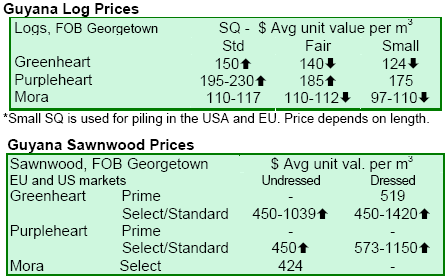
|